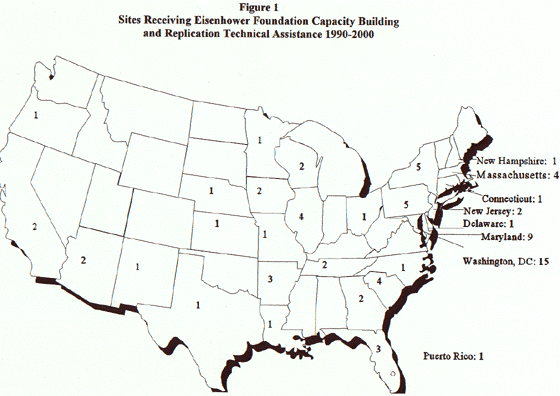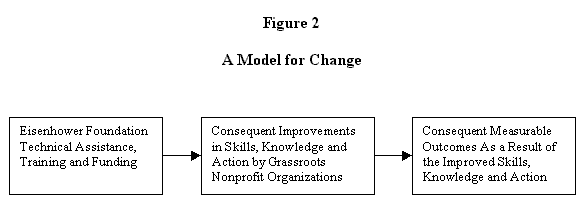Lessons from the Street: Capacity Building and Replication
3. A Model for Change
Nonprofit community development corporations pursuing economic development have been successful in capacity building and replication (Chapter 1), in part because there are excellent technical assistance and training opportunities for them -- for example, from the Center for Community Change in Washington, DC and the Development Training Institute in Baltimore, Maryland. But we know less about how to best provide technical assistance for capacity building and replication to grassroots nonprofit organizations working in "softer" fields -- like child development, youth development, public school innovation, job training, job placement, advocacy, crime prevention, violence prevention, drug prevention and community-police partnerships.
This report is primarily about the latter groups. The report is based on street level experience by the Milton S. Eisenhower Foundation from roughly 1990 to 2000. During that time, the Foundation sought to enhance the capacity of, or replicate, over eighty grassroots nonprofit organizations in twenty-seven states, the District of Columbia and Puerto Rico. Figure 1 shows their geographic distribution. Appendix 1 lists the organizations. These groups had annual budgets that ranged from $45,000 per year to well over $1M per year. Almost all were African American, Latino or Asian American groups in inner cities. The Eisenhower Foundation financed capacity building, replication, or both, through grants from eleven major foundations, four federal departments, eight major corporations and over fifty other national and local matching partners. For some of the replications, police chiefs in eleven cities supplied as in-kind match officers to work with civilian staff. (See Acknowledgments.)

Each funding source had its own restrictions. Some funds were for capacity building technical assistance only. Sometimes the forms of capacity building were restricted by funders. Other sources provided funds primarily for replication, and allowed some capacity building at the nonprofit organization that hosted the replication.
Figure 2 summarizes the model of change used by the Foundation. As the model shows, we began with technical assistance and training by the Foundation in capacity building, technical assistance in replication, funding to sites, or some combination. This we anticipated would result in improvements in skills, knowledge and action by the nonprofit organizations. Crucially, we then anticipated measurable outcomes that could be attributable to the improved skills, knowledge and action. For example, such outcomes might include more funds raised by the organization or better school performance by youth served by the organization.

In social science terms, Foundation technical assistance, training and funding represented inputs, or "independent variables"; consequent grassroots organization improvements in skills, knowledge and action represented "proximate variables"; and consequent measurable outcomes represented "dependent variables."
The rest of this report is devoted to summarizing how well the model of Figure 1 worked. Chapter 4 assesses the specific kinds of technical assistance and training inputs used by the Foundation to build capacity. Chapter 5 evaluates the skills, knowledge, and action that did or did not result and identifies measurable outcomes for capacity building assistance and training. Chapter 6 summarizes lessons learned in capacity building. Chapter 7 reviews lessons learned in replication. Chapter 8 asks where we go next with the knowledge that the Foundation has assembled.
Previous Section | Next Section | Select to go | Publications | Home